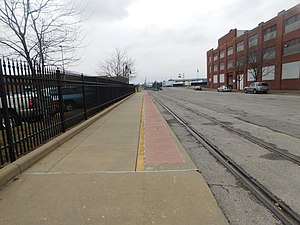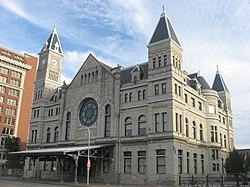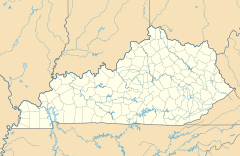Union Station (Louisville)
Louisville, KY | ||||||||||||||||||||||||||||||||||||||||||||||||||||
|---|---|---|---|---|---|---|---|---|---|---|---|---|---|---|---|---|---|---|---|---|---|---|---|---|---|---|---|---|---|---|---|---|---|---|---|---|---|---|---|---|---|---|---|---|---|---|---|---|---|---|---|---|
| inter-city rail station | ||||||||||||||||||||||||||||||||||||||||||||||||||||
 The former platform for the Kentucky Cardinal at Louisville Union Station. | ||||||||||||||||||||||||||||||||||||||||||||||||||||
| General information | ||||||||||||||||||||||||||||||||||||||||||||||||||||
| Location | 1000 West Broadway, Louisville, Kentucky USA | |||||||||||||||||||||||||||||||||||||||||||||||||||
| Coordinates | 38°14′46″N 85°46′8″W / 38.24611°N 85.76889°W | |||||||||||||||||||||||||||||||||||||||||||||||||||
| Tracks | 1 | |||||||||||||||||||||||||||||||||||||||||||||||||||
| Construction | ||||||||||||||||||||||||||||||||||||||||||||||||||||
| Architect | F.W. Mowbray, Col Henry C. Wolters | |||||||||||||||||||||||||||||||||||||||||||||||||||
| Architectural style | Romanesque | |||||||||||||||||||||||||||||||||||||||||||||||||||
| History | ||||||||||||||||||||||||||||||||||||||||||||||||||||
| Opened | 1889 | |||||||||||||||||||||||||||||||||||||||||||||||||||
| Closed | 1979 (first time) July 5, 2003 (second time) | |||||||||||||||||||||||||||||||||||||||||||||||||||
| Former services | ||||||||||||||||||||||||||||||||||||||||||||||||||||
| ||||||||||||||||||||||||||||||||||||||||||||||||||||
| ||||||||||||||||||||||||||||||||||||||||||||||||||||
Union Station | ||||||||||||||||||||||||||||||||||||||||||||||||||||
 Front and western side at sunset | ||||||||||||||||||||||||||||||||||||||||||||||||||||
| NRHP reference No. | 75000777[1] | |||||||||||||||||||||||||||||||||||||||||||||||||||
| Added to NRHP | August 11, 1975 | |||||||||||||||||||||||||||||||||||||||||||||||||||
| Location | ||||||||||||||||||||||||||||||||||||||||||||||||||||
 | ||||||||||||||||||||||||||||||||||||||||||||||||||||
The Union Station of
Construction
Construction of the station began in 1880, but completion was delayed until 1889 due to rising costs totaling at $310,656.47. Local contractors constructed all but the clock tower. Architect Col Henry C. Wolters is credited with the design and supervision of the original structure.[3] Architect F. W. Mowbray was specifically hired for the project, which was to reflect the Richardsonian Romanesque style of architecture. Its exterior was made of limestone ashlar, mostly from Bowling Green, Kentucky, although that from Bedford, Indiana was used for its trim. The roof was made of a slate covering protecting iron and heavy wood. Architectural features include a clock tower, smaller towers, turrets, a facade of considerable size, and barreled vaulting.[4] This station was a street-running station.
The interior was no less impressive. The atrium, dining, and ladies' retiring rooms on the first floor were quite spacious. A wrought iron balcony overlooked the atrium. Soft lighting of the facility came from rose-colored windows on both sides of the atrium. The walls were made of marble from Georgia, as well as oak and southern pine. Ceramic tiles covered the floor.[5]
History
Union Station provided the entrance to Louisville for many visitors, with its height being the 1920s, when it served 58 trains a day. As a Union Station, it served not only the L&N railroad, but also the
Three separate United States presidents arrived in Louisville by Union Station. The lobby was once graced by a performance by Sarah Bernhardt.[5]

On July 17, 1905, a fire occurred in the facility. The structure was unusable until it reopened the following December. A temporary structure was used in its place during the restoration. The rose-colored windows were replaced due to the fire with an 84-paneled stained glass skylight that became a feature of the barrel-vaulting tower. The Ohio River flood of 1937 also saw the structure close for twelve days.[5]
L&N would eventually sell Union Station to TARC, which spent two million dollars from 1979 to 1980 to restore it. Since then it has served as administration offices for TARC.[5]
In October 2010, TARC announced plans to use a grant from the U.S. Department of Transportation to restore all 278 windows at the 120-year-old Union Station, including 40 made of stained glass. Union Station will also get a new geothermal-energy system. Combined with the window restoration, TARC estimates its energy savings will be $58,000 per year.[7]
Major named trains served at the station
Until the 1950s and 1960s the station served several prominent trains.
- Chicago, Indianapolis, and Louisville Railway(Monon Railroad):
- Chicago, Illinois– Louisville
- Louisville & Nashville:
- Azalean, New Orleans, Louisiana, with western branch to Memphis, Tennessee
- Cincinnati, Ohio – Jacksonville, Florida
- Florida Arrow (winter train, pooled with the Pennsylvania Railroad and others), Chicago–Miami (and Sarasota and St. Petersburg)
- Humming Bird, Cincinnati, Ohio – New Orleans
- Pan-American, New York, New York – New Orleans
- Miami, Florida
- unnamed trains to Evansville
- unnamed trains to Lexington, Kentucky via Frankfort, Kentucky
- Azalean,
- Pennsylvania Railroad (PRR):
- Kentuckian, Chicago – Louisville
- Union, Chicago – Louisville branch (diverting from Chicago-Cincinnati branch at Logansport, Indiana)
Connecting PRR trains to
- American, Metropolitan, Penn Texas and St. Louisan
Connecting PRR train to
- Northern Arrow (Mackinaw City, Michigan – Cincinnati)
See also
- List of attractions and events in the Louisville metropolitan area
- Union Station (Owensboro, Kentucky)
- Humming Bird
- Pan-American
- South Wind
- Floridian
References
- ^ "National Register Information System". National Register of Historic Places. National Park Service. April 15, 2008.
- ^ Kleber 2000, p. 897
- ProQuest 1081995288.
- ^ Kleber 2000, pp. 897–898
- ^ a b c d e Kleber 2000, p. 898
- ^ Sanders 2006, p. 221
- ^ Ivey, Steve (October 28, 2010). "TARC gets $9 million in federal grants". Louisville Business First.
Bibliography
- Kleber, John E. (2000). Encyclopedia of Louisville. University Press of Kentucky. ISBN 978-0813121000.
- Sanders, Craig (2006). Amtrak in the Heartland. Bloomington, Indiana: ISBN 978-0-253-34705-3.

